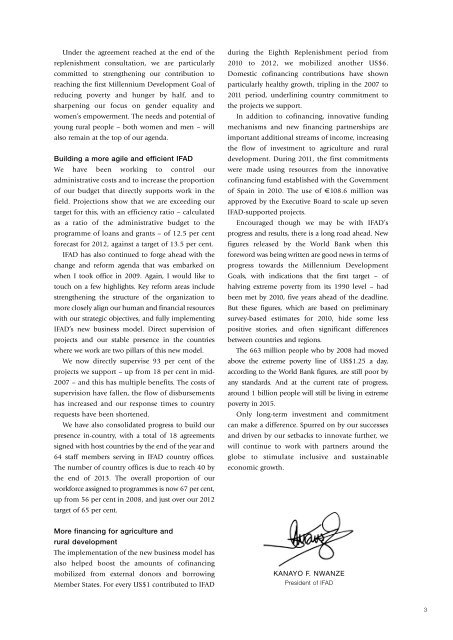ANNUAL REPORT 2011 - IFAD
ANNUAL REPORT 2011 - IFAD
ANNUAL REPORT 2011 - IFAD
You also want an ePaper? Increase the reach of your titles
YUMPU automatically turns print PDFs into web optimized ePapers that Google loves.
Under the agreement reached at the end of the<br />
replenishment consultation, we are particularly<br />
committed to strengthening our contribution to<br />
reaching the first Millennium Development Goal of<br />
reducing poverty and hunger by half, and to<br />
sharpening our focus on gender equality and<br />
women’s empowerment. The needs and potential of<br />
young rural people − both women and men − will<br />
also remain at the top of our agenda.<br />
Building a more agile and efficient <strong>IFAD</strong><br />
We have been working to control our<br />
administrative costs and to increase the proportion<br />
of our budget that directly supports work in the<br />
field. Projections show that we are exceeding our<br />
target for this, with an efficiency ratio – calculated<br />
as a ratio of the administrative budget to the<br />
programme of loans and grants – of 12.5 per cent<br />
forecast for 2012, against a target of 13.5 per cent.<br />
<strong>IFAD</strong> has also continued to forge ahead with the<br />
change and reform agenda that was embarked on<br />
when I took office in 2009. Again, I would like to<br />
touch on a few highlights. Key reform areas include<br />
strengthening the structure of the organization to<br />
more closely align our human and financial resources<br />
with our strategic objectives, and fully implementing<br />
<strong>IFAD</strong>’s new business model. Direct supervision of<br />
projects and our stable presence in the countries<br />
where we work are two pillars of this new model.<br />
We now directly supervise 93 per cent of the<br />
projects we support – up from 18 per cent in mid-<br />
2007 – and this has multiple benefits. The costs of<br />
supervision have fallen, the flow of disbursements<br />
has increased and our response times to country<br />
requests have been shortened.<br />
We have also consolidated progress to build our<br />
presence in-country, with a total of 18 agreements<br />
signed with host countries by the end of the year and<br />
64 staff members serving in <strong>IFAD</strong> country offices.<br />
The number of country offices is due to reach 40 by<br />
the end of 2013. The overall proportion of our<br />
workforce assigned to programmes is now 67 per cent,<br />
up from 56 per cent in 2008, and just over our 2012<br />
target of 65 per cent.<br />
More financing for agriculture and<br />
rural development<br />
The implementation of the new business model has<br />
also helped boost the amounts of cofinancing<br />
mobilized from external donors and borrowing<br />
Member States. For every US$1 contributed to <strong>IFAD</strong><br />
during the Eighth Replenishment period from<br />
2010 to 2012, we mobilized another US$6.<br />
Domestic cofinancing contributions have shown<br />
particularly healthy growth, tripling in the 2007 to<br />
<strong>2011</strong> period, underlining country commitment to<br />
the projects we support.<br />
In addition to cofinancing, innovative funding<br />
mechanisms and new financing partnerships are<br />
important additional streams of income, increasing<br />
the flow of investment to agriculture and rural<br />
development. During <strong>2011</strong>, the first commitments<br />
were made using resources from the innovative<br />
cofinancing fund established with the Government<br />
of Spain in 2010. The use of €108.6 million was<br />
approved by the Executive Board to scale up seven<br />
<strong>IFAD</strong>-supported projects.<br />
Encouraged though we may be with <strong>IFAD</strong>’s<br />
progress and results, there is a long road ahead. New<br />
figures released by the World Bank when this<br />
foreword was being written are good news in terms of<br />
progress towards the Millennium Development<br />
Goals, with indications that the first target – of<br />
halving extreme poverty from its 1990 level – had<br />
been met by 2010, five years ahead of the deadline.<br />
But these figures, which are based on preliminary<br />
survey-based estimates for 2010, hide some less<br />
positive stories, and often significant differences<br />
between countries and regions.<br />
The 663 million people who by 2008 had moved<br />
above the extreme poverty line of US$1.25 a day,<br />
according to the World Bank figures, are still poor by<br />
any standards. And at the current rate of progress,<br />
around 1 billion people will still be living in extreme<br />
poverty in 2015.<br />
Only long-term investment and commitment<br />
can make a difference. Spurred on by our successes<br />
and driven by our setbacks to innovate further, we<br />
will continue to work with partners around the<br />
globe to stimulate inclusive and sustainable<br />
economic growth.<br />
KANAYO F. NWANZE<br />
President of <strong>IFAD</strong><br />
3

















